Country Report: Hungary
Although Hungary has posted the third-highest economic growth rate in the EU since 2014, its healthcare system is struggling-dictating the need for new efforts if the country is to regain its dominance as a central and eastern European-region trailblazer in the life sciences.
This sponsored supplement was produced by Focus Reports.
Project Publisher: Mariuca Georgescu
Senior Editor: Louis Haynes
Project Director: Jun Wakabayashi
Coordinator: Roxane Höck
Project Assistant: Brandon Mourich
Cover Illustration: Carmen Reyes (Inspired by László Moholy-Nagy)
For exclusive interviews and more info, please log onto www.pharmaboardroom.com or write to contact@focusreports.net
Seeking New Horizons
When it comes to Central and Eastern European countries, Hungary has always managed to display a sense of vibrancy and perseverance when it comes to making a name for this small nation of roughly 10 million inhabitants. “If you look at the country, we are clearly standing out in terms of political and economic stability,” states the President of the Hungarian Investment Promotion Agency Róbert Ésik. Even though the country has just resurfaced from what has been described as the worst recession in 80 years, primary macroeconomic indicators are now painting a “robust picture” with “the deficit hovering below 3 percent since 2012 and growth rates ranked as the 3rd highest in the EU since 2014,” according to Ésik.

Hungary thus clearly performs well within Europe in terms of raw economic statistics, but further efforts are still required if the country is to ever regain its dominance as a CEE-region leader and trailblazer for healthcare and life sciences. Certain gaps are evident. “The vast majority of stakeholders agree that Hungary’s healthcare system remains severely underfinanced, even when stacked up against some of its [more underdeveloped] neighbors,” points out the vice president of the Hungarian Hospital Association Dr. György Velkey. “At some point, the healthcare agenda simply fell by the wayside as the government’s focus shifted elsewhere… we’re now in a position where there’s going to have to be considerably greater political will before we can start making inroads into the massive backlog of issues encumbering our country’s overburdened healthcare system… mobilizing that political willingness is a prerequisite to ever being able to restore the system to its former glory.”
EXTENDING THE LEGACY
Hungarian pharmaceuticals certainly enjoy an illustrious heritage and fine reputation. "We have to remember that our local pharma industry is steeped in centuries-old tradition," proudly acknowledges the minister of foreign affairs and trade, Péter Szijjártó. "Last century was notable for the emergence of a large number of highly successful home-grown drug developers and manufacturers," he recalls. "Then, in the mid-1990s, most of them were duly bought up and acquired by foreign multinationals thus conferring upon them both an international dimension and a more profound technical knowledge base that could propel them to the next level." For him, it is very much this legacy that has "ensured that local production has been able to maintain pace with even the most advanced economies around the globe."
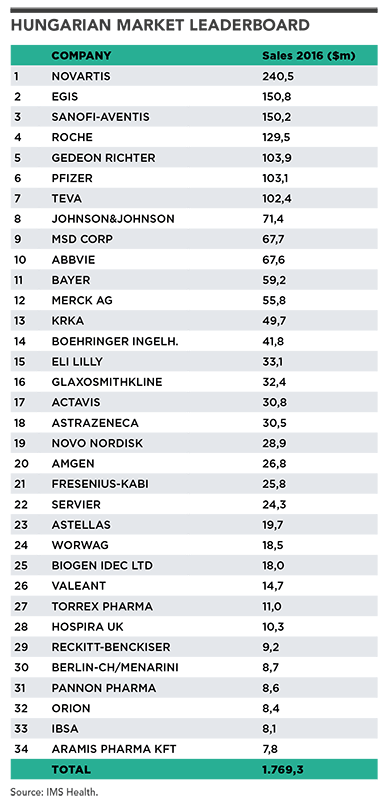
Meanwhile, the local pharma industry has functioned as a steadfast and important contributor to the national economy. According to Dr. Lívia Ilku, director of MAGYOSZ, the main association representing in-country pharma manufacturers, the sector "now generates employment for over 14,000 people and delivers a full 5 percent of the nation's GPD" with her "own members exporting as much as HUF 900 (USD 3.2) billion worth of products each year." Nor should anyone forget the sector's longstanding function in fostering value creation and modernity. "Pharmaceutical development and manufacturing has been and very much remains a critical driver of innovation within the national economy, sustaining the employment of an entire cadre of leading-edge scientists," declares Minister Szijjártó. Indeed, "from an investment standpoint, pharma firms are now investing approximately HUF 80 billion (USD 280 million) per annum, and that's on top of the HUF 70 billion (USD 245 million) that is habitually ploughed into R&D," concurs Ilku.

Péter Szijjártó, minister of foreign affairs and trade
These figures serve to highlight the pivotal role that pharma has unequivocally played in the development of the country's socio-economic fabric. However, many industry insiders still feel that their sector's true worth is often overlooked and undervalued especially when it comes to the nuts and bolts of decision-making on financing public health provision. A series of cost-containment measures aimed at tackling the nation's mounting level of sovereign debt in the aftermath of the financial crisis has bequeathed a severely strained public healthcare system catering to roughly 10 million citizens, with increasingly limited resources to support its own weight.
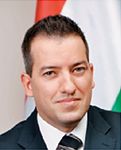
Róbert Ésik, president, Hungarian Investment Promotion Agency (HIPA)
"We have essentially been avoiding this elephant in the room for the past twenty years, never daring to state what we know: namely that the use of public healthcare services does not reflect the needs of society, but rather the interests of the institutional system," candidly acknowledges Dr. Zoltán Ónodi-Szűcs, the freshly minted Secretary of State for Health. Since stepping into the public spotlight in October 2015, he has strived to create a public healthcare system that "genuinely serves the interests of the public, rather than merely just those of the institutions," but warns "any significant reform will undoubtedly require sacrifice."

Dr. György Velkey, vice president of the Hungarian Hospital Association
Sacrifice, however, is certainly not a new concept for pharmaceutical companies in Hungary. Under the auspices of the former Secretary of State for Health Dr. Miklós Szócska, the industry in 2011 faced a 30 percent decrease in pharmaceutical spending, coupled with competitive taxation methods and a blind-bidding mechanism to collectively decrease the price of medicines. Other measures such as pay-for-performance, negative incentives of various therapies, and joint national procurements were also used to engender savings and reduce frivolous consumption. "As you can see, we accomplished a lot, despite encountering resistance and having to carry out very intense negotiations with industry professionals and patient groups," proudly recalls Szócska, who is now the incumbent director of the Health Services Management Training Center at Semmelweis University.

Dr. Lívia Ilku, director, MAGYOSZ
The industry itself, however, is already feeling the pinch. Compounded by the Russia-Ukraine conflict which has damaged two erstwhile major export destination markets for domestic manufacturers, and an amplified compliance burden relating to pharmacovigilance, "many companies have been compelled to implement cost-cutting initiatives to stay competitive and truly come to terms with a new reality," laments Ilku. For a sector that has contributed so much to Hungary's evolution-particularly in terms of innovation, job creation, and improving health outcomes- this has been pretty difficult to stomach.

Dr. Miklós Szócska, former secretary of state for health and director of the Health Services Management Training Center, Semmelweis University
Nevertheless, Ilku believes collaborative efforts between government and industry stakeholders are steadily improving and that there is light at the end of the tunnel. "We're actually right now on the cusp of establishing a strategic agreement with the government, that if successful, will enshrine the government's commitment to the proper development of this industry," she confirms. Under the agreement, decision makers would align more closely, on the legal front. The move would also foster greater industry participation through additional public tenders and potentially yield a more transparent and stakeholder-inclusive determination of the drug budget.
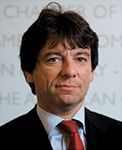
Dr. Csaba Szokodi, chair of AmCham's Healthy Nation Policy Task Force
HEALTH EQUALS WEALTH
Chronic underfinancing is a common pitfall for many former Communist states and Hungary is no exception. Total health spending ultimately accounted for 7.4 percent of GDP in Hungary in 2013, with per capita spending reaching USD 1719, compared to the average of 9.3 percent and USD 3453 respectively across OECD countries. Moreover, only 65 percent of total health spending was funded through public sources, decreasing by roughly six percent from the last decade and now sitting well below the OECD average of 73 percent.

Claire Roger, general manager, GSK
"This indicates that healthcare is not a top priority for the government, and that really constitutes a problem," argues Dr. Csaba Szokodi, chair of AmCham's Healthy Nation Policy Task Force. "We really need to focus minds on rendering healthcare a major topic in the political arena. We see the government eager to invest in research and development and clinical trials in the biotech and pharmaceutical industries, but not in the healthcare system as a whole. If you speak to a government official and ask if healthcare is good for the country, they will agree to initiatives that attract investment, but when you speak about creating a sustainable healthcare system there is little response or sense of urgency. I strongly believe, that these two dimensions should be strongly connected," he reasons.
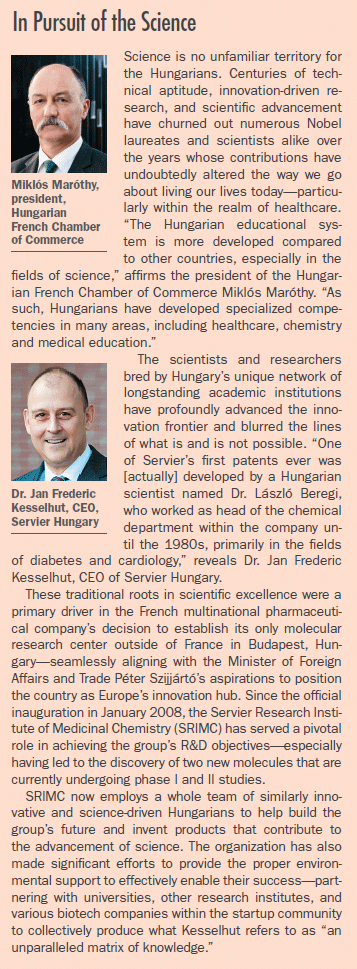
Ultimately, "You require healthy workers to have a healthy economy," as general manager of GSK Claire Roger aptly puts it. She does note, however, that "recognition of the need to improve the healthcare ecosystem is slowly increasing." "The new fiscal budget has announced a potential increase in not only salaries for healthcare workers, but also the pharmaceutical budget-the first time in several years-which is very much a step in the right direction," she analyses.

GSK's Vaccine Plant in Gödöllö (Hungary)
When health priorities do not align with the tone at the top, it's ultimately the patients who inherit the short end of the stick. "More affluent people in Budapest enjoy a life expectancy similar to that of the Swiss. However, some districts in the city register life expectancies of up to 10 years less," exclaims Dr. István Vályi-Nagy, director general of Unified Szent István & Szent László Hospital. "One of the reasons for this is that a certain strata of citizens don't seem to take any responsibility for managing their illnesses: some can be quite ignorant, while others fail to undertake the normal prevention techniques. There are, for example, a lot of elderly people who lived most of their active lives under the paternalism of the communist system, many of whom are not in good condition health-wise. Most smoke and drink too much, eat fatty foods and don't exercise and thus end up suffering from a variety of lifestyle diseases, often concurrently," he notes.

Dr. István Vályi-Nagy, director general of Unified Szent István & Szent László Hospital
Country director of Swiss pharmaceutical company IBSA, Anna Wienner believes that the onus must be on the industry itself to mitigate this state of affairs through promotion of health education initiatives. "Because of the historically passive and subservient relationship between doctors and patients in Hungary, levels of patient participation remain extremely low. This habit is difficult to break, but patients must, at some point, start taking the initiative to improve and manage their own health. If you analyze the statistics on Hungarian life expectancy, we rank towards the bottom in Europe. I believe that the pharmaceutical companies themselves thus have an obligation to work to increase health literacy rates," she argues.

Anna Wienner, country director, IBSA
"Today we are working with patient groups, for specific therapeutic areas such as rheumatology and also in rural areas to raise and increase awareness. Supporting a patient association is actually very easy, but the power of patient associations in Hungary remains terribly weak, especially when compared to Western Europe. In the future this simply has to change and I believe it inevitably will, just so long as we take steps to properly empower them," declares Wienner.
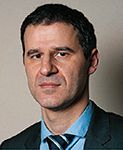
Zsolt Józsa, general manager, Novo Nordisk
PATHWAYS TO FINANCING INNOVATION
Hungary operates under a state-owned universal National Health Insurance Fund (OEP), completely financed through mandatory tax contributions from employers and employees. "From a drug reimbursement point of view, we have one of the most complex and comprehensive regulatory frameworks in Europe, which aims to cover all medical and medicinal needs for society-even when it comes to aspects like hospital and outpatient care," declares OEP's head of pricing support Dr. Judit Bidló.
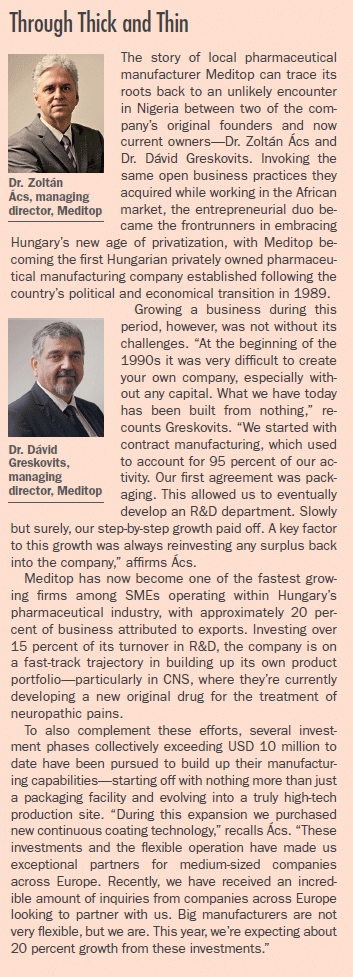
According to Bidló, one of the primary challenges now, which also extends to every single healthcare market worldwide, is accommodating the growing premiums associated with increasingly innovative therapies and assessing alternative financing methods to introduce them into the system-which is often the root cause of delays for companies seeking reimbursement approval. "Compared to 10 or 15 years ago, the drug mixture has completely changed. The products on the market today are of course much more efficient, but also much higher in price, and correspondingly, it's become much more challenging for payers to cover them-especially with limited resources. Nowadays, it is crucial to define specific outcome criteria and appropriate benchmarks to ensure that drugs admitted into reimbursement perform as expected, else we risk the opportunity costs of not covering other therapies that could've saved a patient's life," explains Bidló.

Inside Meditop's packaging and coating department (Hungary)
This trend is especially relevant in the field of oncology, where Dr. György Bodoky, head of clinical oncology at Unified Szent István & Szent László Hospital, uses the expression "financial toxicity" to describe the unsustainable price of innovation, requiring "an urgent need for close collaboration between government, payers, healthcare professionals and the pharma industry to solve this rapidly emerging issue."

Judit Bidló, head of pricing support, OEP
Janssen has been particularly successful in effectively demonstrating the fair value of innovation through the use of real-world evidence, and in turn, obtaining product reimbursement. "There's a unique opportunity to access data that encompasses the whole population covered under the OEP," illustrates Andreas Woitossek, head of strategy and outcomes CEE. "Through this data, you can see how patients are developing through the system, but you can also see the performance of your drugs in a market. With studies supported by real-world evidence, you have a much stronger position to show the added value of existing products for the patients, while gaining a much better understanding of which patient population would benefit the most from our new product launches."

Dr. György Bodoky, head of clinical oncology at Unified Szent István & Szent László Hospital
"In an open and transparent way, showing the value and identifying patient groups that can benefit from our innovations, and following up with real-world evidence to demonstrate efficacy before and after launch has been pivotal. For instance, we have an important treatment option for psoriasis, which is administered only 4 times per year. Based on our follow-ups with patients, compared to competitors, our product has been able to boast better patient compliance with fewer side effects, adding to our value proposition and truly demonstrating that our drug goes beyond clinical studies and actually improves real-world health outcomes," details Woitossek.

Andreas Woitossek, head of strategy and outcomes CEE, Janssen-Cilag
In terms of alternative financing avenues, "CSL Behring was the major facilitator in creating a special health insurance fund for patients with primary immune deficiency to increase their access to immunoglobulin therapies. This is the same funding system that has been created in oncology. Now that hospitals do not have to cover the cost of immunoglobulin for the treatment of primary immune deficiency from their own budgets, they are better able to treat patients: patients, doctors and payers all manifestly benefitting. We are now working to establish more of these types of funds to allow reimbursement for the same therapy for patients with other types of immune diseases in neurology and hematology," promises Dr. Attila Luckács, managing director of CSL Behring.
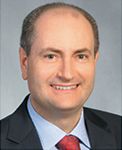
Dr. Attila Lukács, managing director, CSL Behring
FIDDLING TO A DIFFERENT TUNE
One of the most salient challenges crippling Hungary's effort to move the health agenda forward is the mass exodus of healthcare practitioners-placing significant pressures on an already overwhelmed system. "One of the main factors provoking the brain drain is high asymmetry in doctors' salaries when comparing the Hungarian market to Western Europe, bearing in mind that the workload in Hungary is usually double that of many other European countries," underscores Dr. József Timár, president of the doctoral council at Semmelweis University.

Dr. József Timár, president of the doctoral council at Semmelweis University
Such circumstances have invariably factored into the way healthcare practitioners approach patient care in Hungary, requiring much more tailored strategies from pharmaceutical companies when executing promotional campaigns and commercializing products. "GPs in Hungary tend to participate in a lot of events, congresses, and educational seminars-but the type of therapies prescribed has been changing only very slowly," analyzes the country manager of Berlin-Chemie Dr. Péter Oláh.

Dr. Péter Oláh, country manager, Berlin-Chemie
For example, we have an antidiabetic product whose indication was approved for treating pre-diabetic patients. We have been promoting this new indication to GPs and specialists for more than six months, but we realized that doctors are already overworked and display limited interest in what is, after all, a rather preventive indication. I think this phenomenon is symptomatic of the current healthcare system in force in which the insurance fund offers little incentive to physicians to focus on prevention. Additionally, over 200 GP positions are empty in the country, leading to oversized patient pool for the rest," he reflects.
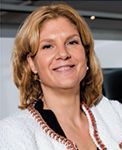
Nienke Feenstra, commercial lead, Takeda
Other companies have chosen to dedicate their efforts to first understand the entire care spectrum, particularly from a patients' perspective. "For instance, we developed a questionnaire in collaboration with six leading hematologists, the myeloma patient organization, and an independent research company to look at what patients with myeloma really experience or encounter," explains Nienke Feenstra, Takeda's commercial lead in Hungary.

"Through in-depth interviews with these patients, we assess both technical aspects, such as first symptoms and treatment regiments, and psychological considerations, such as their personal sentiments, emotional responses, or access to informational support. Essentially, our aim is to obtain a comprehensive and meticulously detailed overview of the total care flow and its unmet needs from a patient perspective for a particular disease first, in order to tailor our approach and address these needs simultaneously when bringing a product to market," she continues.

Andrea Bondár, country manager, LEO Pharma A/S Hungarian Commercial Representative Office
Similarly, Danish dermatology specialist LEO Pharma has adopted this same notion of patient-centricity, but applied it in a more non-conventional fashion, leaving their sales force to focus exclusively on conducting and gathering in-depth market surveys extending to both the patients and doctors. "Following our research we soon realized that the dermatologists are only focusing on treating skin diseases without adequately recognizing and addressing the corresponding psychological anxiety of patients with psoriasis," recounts the affiliate's country manager Dr. Andrea Bondár.

Veronika Ferencz, sales & marketing manager, Exeltis
"Many doctors have also said that they weren't properly equipped to effectively handle the frustration of the patients. As such, we created an online portal for doctors called dermacare.hu to help them acquire the necessary support. The primary objectives of this portal were to help healthcare practitioners stay up-to-date with the latest scientific advancements, better understand the needs of the patients, and establish open communication channels with other doctors in the community," details Bondár.

Dr. Éva Kádár, managing director, Wörwag
Exeltis a mid-sized Spanish enterprise specializing in woman's health has chosen to pursue more traditional models in light of prevailing market dynamics. "Our first entrance to the market was with a product that was entirely new, so we utilized a more traditional marketing strategy- engaging directly with gynecologists and organizing round tables. Hungary traditionally was not a price sensitive market with oral contraceptives, but is now becoming more so with the influx of generics," exclaims sales and marketing manager Veronika Ferencz. "This is why it is very important to have a strong relationship, not just between our sales representatives and the gynecologists but pharmacies as well."

Zsolt Szepesházi, general manager, IMS Health Hungary & Adriatics
In order to truly lead by example and provide the proper tools and support to raise the quality of care in Hungary, "Wörwag has taken a specific interest in raising awareness for the diagnosis and treatment of neuropathy by building up a network of neuropathy centers," describes the managing director of Wörwag Dr. éva Kádár. "This initiative began with the first center opening up in 1998, alongside the establishment of the National Neuropathy Screening and Education Center at Semmelweis University. Since then, this network has expanded to 13 neuropathy centers until today, and we have ambitions of doubling that number to have at least one center in each county by 2020."
SHIFTING UP THE GEARS?
"The past few years delivered a tricky, but comparatively stable environment," assesses the general manager of IMS Health Hungary & Adriatics, Zsolt Szepesházi, when asked to evaluate the country's evolving pharmaceutical market dynamics. All in all, many actors have indeed proved adroit in successfully navigating a doubtlessly complicated, but nonetheless profitable marketplace. Furthermore, with many of the structural fundamentals already soundly embedded, IMS Health is now confidently predicting "year on year single-digit growth of an unspectacular, but solidly reliable 3 to 6 percent."
